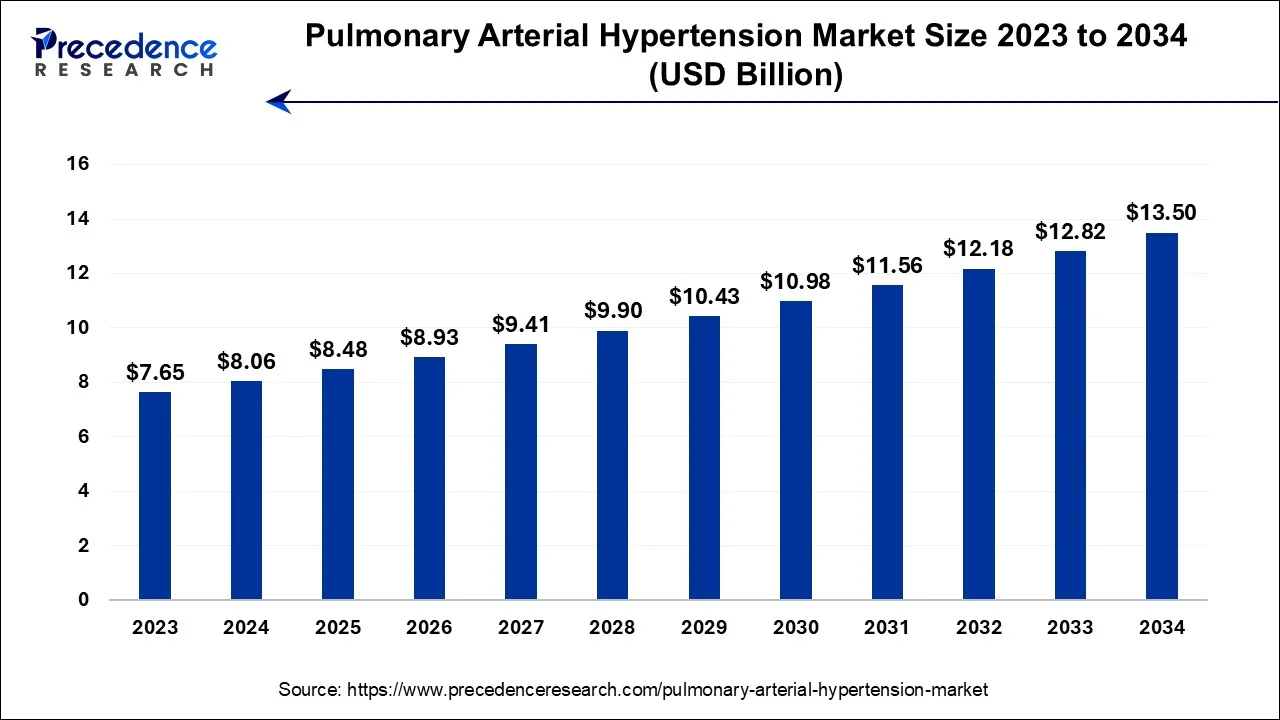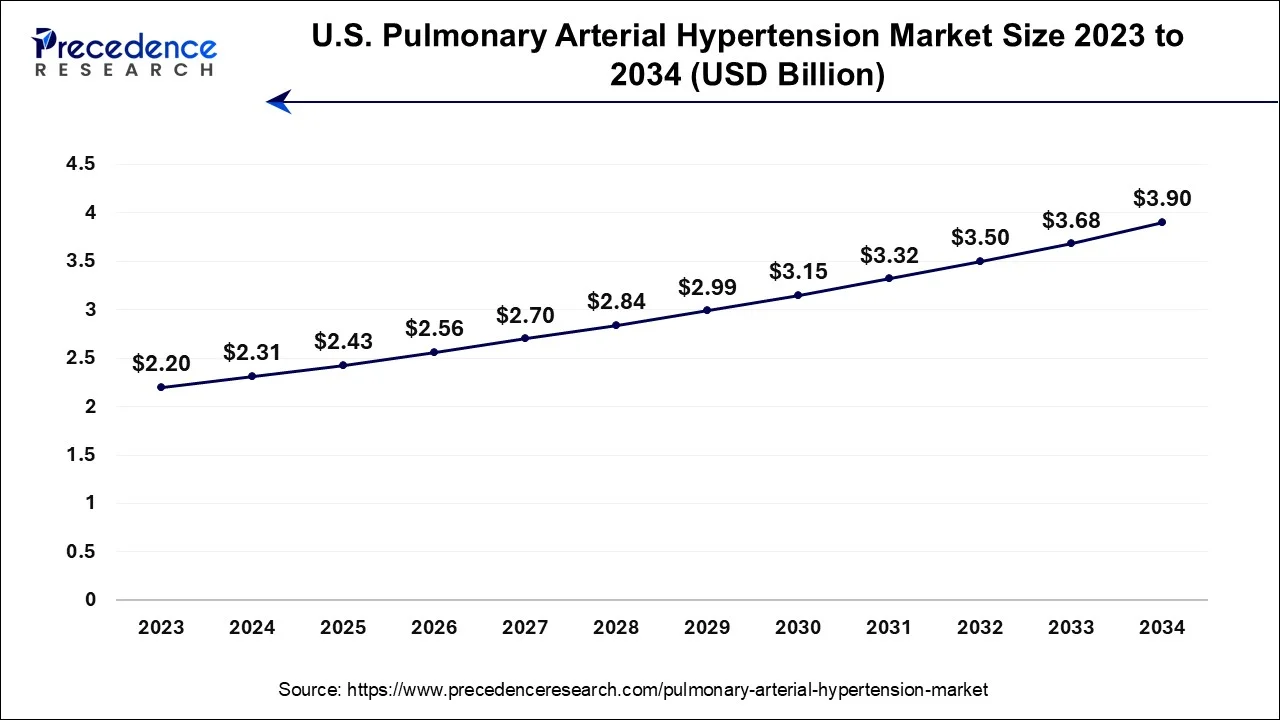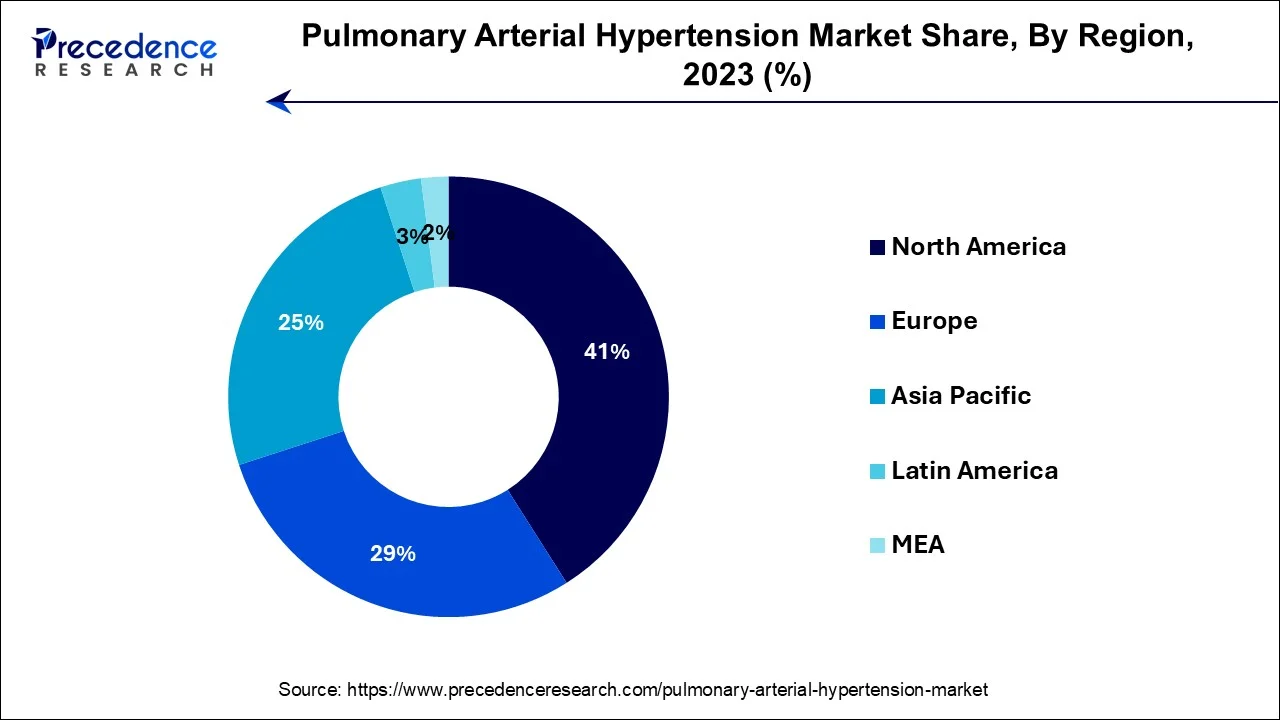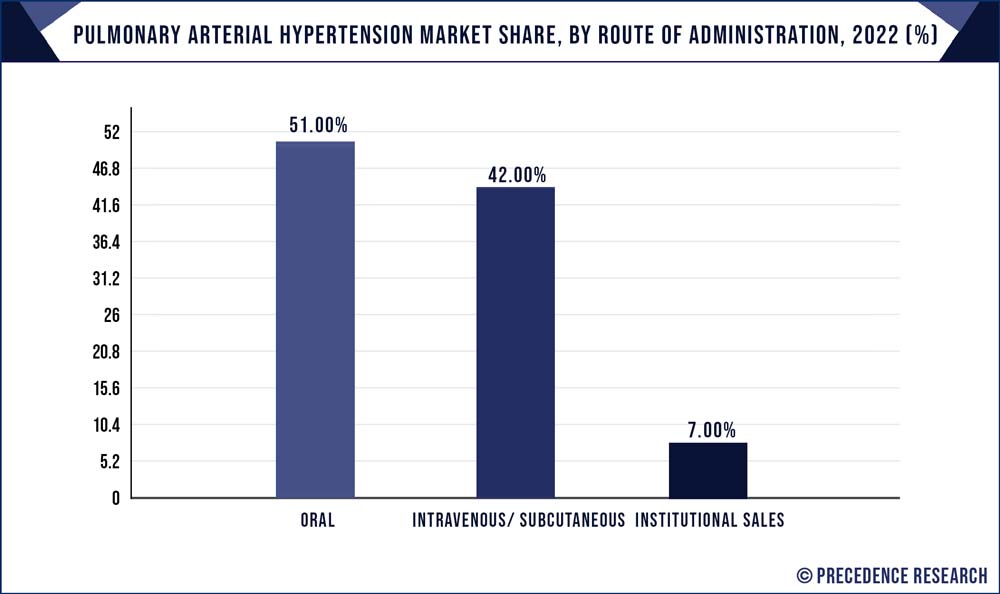January 2025
The global pulmonary arterial hypertension market size accounted for USD 8.06 billion in 2024, grew to USD 8.48 billion in 2025 and is expected to be worth around USD 13.50 billion by 2034, registering a healthy CAGR of 5.30% between 2024 and 2034.
The global pulmonary arterial hypertension market size is estimated at USD 8.06 billion in 2024 and is anticipated to reach around USD 13.50 billion by 2034, registering a notable CAGR of 5.30% between 2024 and 2034.

The U.S. pulmonary arterial hypertension market size accounted for USD 2.31 billion in 2024 and is expected to be worth around USD 3.90billion by 2034, growing at a CAGR of 5.37% from 2024 to 2034.

North America has held the largest revenue share 41% in 2023. North America holds a significant share in the pulmonary arterial hypertension (PAH) market due to several key factors. The region boasts a well-established healthcare infrastructure and advanced research capabilities, fostering the development of innovative PAH treatments. Additionally, high healthcare spending and insurance coverage enhance patient access to expensive PAH therapies.
A greater prevalence of risk factors, such as obesity and cardiovascular diseases, also contributes to a larger patient pool in North America. Furthermore, robust patient advocacy efforts, clinical trials, and early diagnosis initiatives help maintain North America's prominent position in the PAH market.

Asia-Pacific is estimated to observe the fastest expansion with the highest CAGR of 13.3% during the forecast period. The Asia-Pacific region commands a substantial share in the pulmonary arterial hypertension (PAH) market due to several factors. A growing population, increasing healthcare expenditures, and improving healthcare infrastructure have expanded the market's potential. Additionally, a rise in the incidence of PAH, driven by factors like pollution and changing lifestyles, has boosted the demand for treatments.
The presence of a large, underserved patient population, coupled with a surge in awareness and diagnosis, further contributes to the region's market share. Pharmaceutical companies are also increasingly focusing on this region, underscoring its significance in the global PAH market.
The pulmonary arterial hypertension (PAH) market encompasses the sector involving pharmaceuticals and therapies designed to address a rare and life-threatening condition where the pulmonary arteries narrow, causing elevated blood pressure. In recent years, this market has witnessed significant expansion owing to innovations in treatment options like prostacyclin analogs and endothelin receptor antagonists.
Market growth is propelled by heightened awareness, early diagnosis, and an expanding patient base. Nonetheless, it remains a fiercely competitive arena, with ongoing research and development endeavors aimed at enhancing patient outcomes and overall quality of life. This dynamic pharmaceutical sector remains of great interest to pharmaceutical companies.
The pulmonary arterial hypertension (PAH) market is a dynamic and evolving sector aimed at managing a rare yet life-threatening condition characterized by the constriction of pulmonary arteries, resulting in elevated blood pressure within the lungs. In recent times, the PAH market has undergone substantial growth, primarily propelled by breakthroughs in treatment options, including prostacyclin analogs and endothelin receptor antagonists. An increase in disease awareness and early detection efforts have contributed to the expansion of the patient population, making it a fiercely competitive landscape with lucrative prospects for pharmaceutical companies committed to enhancing patient outcomes and quality of life.
Within the PAH market, industry trends underscore the escalating demand for targeted therapies that offer more efficient and minimally invasive solutions. The introduction of advanced diagnostic techniques and biomarker-based approaches for early identification has enabled swifter intervention, ultimately improving patient prognoses. Furthermore, the ascent of precision medicine has enabled personalized treatments, reducing adverse effects and augmenting therapeutic effectiveness.
Critical growth drivers within the PAH market encompass the mounting incidence of the condition, attributable to factors like an aging demographic and enhanced diagnostic capabilities. A consistent stream of research and development initiatives is broadening the therapeutic repertoire, focusing on pioneering drug formulations and combination therapies. Additionally, the increasing healthcare expenditure, particularly in developed regions, bolsters market growth by ensuring greater patient access to advanced treatments.
Nevertheless, the PAH market encounters formidable challenges. The complex nature of the condition's pathophysiology, involving intricate genetic and environmental factors, poses obstacles to treatment development. Stringent regulatory requirements and the substantial cost associated with drug development can decelerate progress. Moreover, reimbursement complexities and disparities within healthcare systems may impede access to cutting-edge therapies for certain patient groups.
In the face of these challenges, the PAH market presents promising business opportunities for pharmaceutical enterprises capable of addressing unmet medical needs and introducing innovative therapies. With a continually expanding patient base, ongoing research breakthroughs, and the potential for more individualized treatment strategies, the PAH market remains an influential area of focus and investment for those aiming to make a substantial difference in patient care.
| Report Coverage | Details |
| Growth Rate from 2024 to 2034 | CAGR of 5.3% |
| Market Size in 2024 | USD 8.06 Billion |
| Market Size by 2034 | USD 13.50 Billion |
| Largest Market | North America |
| Base Year | 2023 |
| Forecast Period | 2024 to 2034 |
| Segments Covered | Drug Class, Type, and Route of Administration, and Region |
| Regions Covered | North America, Europe, Asia-Pacific, Latin America, and Middle East & Africa |
Increasing disease awareness
The surge in awareness about pulmonary arterial hypertension (PAH) is a fundamental catalyst driving the growth of its market. The heightened recognition of PAH among healthcare practitioners and the wider community has profound implications for market expansion. Primarily, this increased awareness leads to the early detection and timely intervention of PAH. With healthcare professionals becoming more informed about the condition, they can spot and diagnose PAH in its initial stages, a pivotal factor in elevating patient outcomes. Swift diagnosis allows for the prompt initiation of treatment, effectively halting disease progression and diminishing potential complications.
Moreover, public awareness campaigns and patient education initiatives empower individuals to identify PAH symptoms, motivating them to seek medical assistance sooner. Consequently, a larger group of patients is diagnosed, creating a surge in demand for PAH treatments and therapies. Furthermore, the escalation of disease awareness also encourages advocacy for broader treatment access. Patient support groups and healthcare organizations can influence healthcare policies, ensuring that PAH patients have improved access to state-of-the-art therapies. In essence, the surge in disease awareness not only enhances patient well-being but also propels the expansion of the PAH market by broadening the patient base and stimulating the demand for advanced treatment solutions.
Complex disease pathophysiology
The intricate and convoluted pathophysiology of pulmonary arterial hypertension (PAH) serves as a formidable obstacle to the market's expansion. PAH's complexity arises from a myriad of genetic, cellular, and environmental factors that collectively contribute to the elevation of blood pressure within the pulmonary arteries.
This intricate disease mechanism presents substantial challenges in comprehending the ailment and in the development of effective treatments. PAH's multifaceted pathophysiology entails abnormalities in the endothelium, smooth muscle cells, inflammatory responses, and the disruption of signaling pathways. Precisely targeting these intricate mechanisms demands a profound comprehension of their complex interactions, requiring customized approaches to treatment. This intricacy translates into a series of obstacles, prolonging the research and development process, which, in turn, extends timelines and increases associated costs.
Furthermore, it can obscure the identification of effective therapeutic targets, given the intricate nature of the disease, rendering it more challenging to develop treatments that achieve the desired outcomes. Consequently, the market grapples with the formidable task of unraveling and addressing this complexity to enhance treatment options for PAH patients.
Early diagnosis and biomarker development
Early detection and the evolution of biomarkers present exceptional prospects within the pulmonary arterial hypertension (PAH) market. The identification of PAH in its initial stages is a pivotal element in advancing patient outcomes, as it allows for timely intervention and the initiation of treatment. The advent of dependable biomarkers capable of recognizing the condition's emergence is a groundbreaking development. To begin, early diagnosis curtails the advancement of PAH, potentially avoiding severe complications and enhancing patients' quality of life, thereby fueling the demand for treatments and therapeutic approaches.
Moreover, the discovery and validation of distinctive biomarkers possess the potential to optimize the diagnostic process, rendering it more precise and efficient. Biomarkers can also aid in monitoring disease progression and gauging the response to treatment. Furthermore, early diagnosis and biomarker-guided methodologies empower the implementation of personalized medicine. Tailored treatments, tailored to an individual's unique biomarker profile, hold the promise of augmenting the effectiveness of treatment while minimizing adverse effects.
In the PAH market, these strides not only benefit patients by elevating their prognosis and overall well-being but also open up substantial avenues for pharmaceutical companies and healthcare providers to innovate diagnostic tools and specific therapeutic interventions. This underscores the critical role of early detection and biomarker development in propelling progress within the PAH market.
Impact of COVID-19
The COVID-19 pandemic has had a mixed impact on the pulmonary arterial hypertension (PAH) market. While it disrupted healthcare systems and clinical trials, delaying the development and approval of new PAH treatments, it also emphasized the importance of telemedicine and remote patient monitoring, potentially improving patient care.
Patients with underlying conditions, including PAH, faced increased risks from COVID-19. This encouraged heightened disease awareness and infection prevention measures, indirectly benefiting the market. The overall impact remains dynamic, with a balance between setbacks and opportunities in the evolving landscape of PAH treatment during and post-pandemic.
According to the drug class, the prostacyclin and prostacyclin analogs segment has held 45% revenue share in 2023. The dominance of the prostacyclin and prostacyclin analogs segment within the pulmonary arterial hypertension (PAH) market can be attributed to their well-established track record in widening pulmonary blood vessels, alleviating arterial pressure, and enhancing patients' exercise capacity and overall well-being. These medications, frequently administered through various delivery methods, have traditionally held a central role in PAH treatment. Their effectiveness in mitigating symptoms and retarding the progression of the condition positions them as the preferred choice for many patients and healthcare providers, thus substantiating their substantial share in the PAH market.
The SGC simulators segment is anticipated to expand at a significantly CAGR of 5% during the projected period. The SGC (Soluble Guanylate Cyclase) simulators segment holds a significant growth in the pulmonary arterial hypertension (PAH) market due to its effectiveness in addressing the underlying molecular mechanisms of PAH. These simulators target the NO-sGC-cGMP pathway, a critical component in PAH pathophysiology. By promoting vasodilation and reducing vascular remodeling, they offer a promising approach to managing the condition. Furthermore, SGC simulators have demonstrated positive clinical outcomes, leading to their widespread adoption and contributing to their substantial market growth in the treatment landscape for PAH.
In 2023, the branded segment had the highest market share of 42% on the basis of the type. The branded segment holds a significant share in the pulmonary arterial hypertension (PAH) market due to several factors. First, branded medications often have a strong clinical track record, instilling trust among healthcare providers and patients. Second, pharmaceutical companies invest heavily in research and development to create innovative and effective branded therapies. Third, branding allows companies to differentiate their products in a competitive market, supporting premium pricing.
Additionally, the exclusive patents of branded drugs provide a monopoly for a period, contributing to a higher market share. These factors combined make the branded segment a dominant force in the PAH market.
The generics segment is anticipated to expand at the fastest rate over the projected period. Generics hold a significant growth in the pulmonary arterial hypertension (PAH) market primarily due to the expiration of patents on some branded PAH drugs. As patents have lapsed, generic versions of these medications have entered the market, offering cost-effective alternatives.
These generic options make PAH treatment more affordable and accessible to a broader patient population, especially in regions with limited healthcare resources or cost-conscious healthcare systems. This increased affordability and availability of generics have contributed to their major growth in the PAH market, catering to patients who may not have access to expensive branded alternatives.
In 2023, the oral segment had the highest market share of 51% on the basis of the route of administration. The significant dominance of the oral segment in the pulmonary arterial hypertension (PAH) market is attributed to its practicality and patient compliance. Oral medications are favored for their ease of administration compared to more invasive delivery methods like intravenous or inhaled treatments, making them the go-to option for long-term therapy. This non-invasive approach enhances patient comfort and adherence to treatment plans. Moreover, ongoing advancements in the development of oral PAH drugs, featuring enhanced efficacy and fewer side effects, further establish the prominence of this segment. As a result, oral treatments stand as a preferred choice for both patients and healthcare providers in the management of PAH.

The intravenous/ subcutaneous segment is anticipated to expand at the fastest rate over the projected period. The intravenous/subcutaneous segment commands a substantial share in the pulmonary arterial hypertension (PAH) market due to its effectiveness in delivering rapid and precise drug administration. This mode of treatment enables immediate relief from PAH symptoms, making it a preferred option for severe cases. Furthermore, intravenous/subcutaneous therapies are often used when oral medications prove insufficient. While they require professional administration, these methods offer a direct and consistent way to manage PAH, contributing to their significant market share, particularly in addressing the critical needs of patients with advanced stages of the disease.
Segments Covered in the Report
By Drug Class
By Type
By Route of Administration
By Geography
For inquiries regarding discounts, bulk purchases, or customization requests, please contact us at sales@precedenceresearch.com
No cookie-cutter, only authentic analysis – take the 1st step to become a Precedence Research client
January 2025
November 2024
December 2024
May 2024